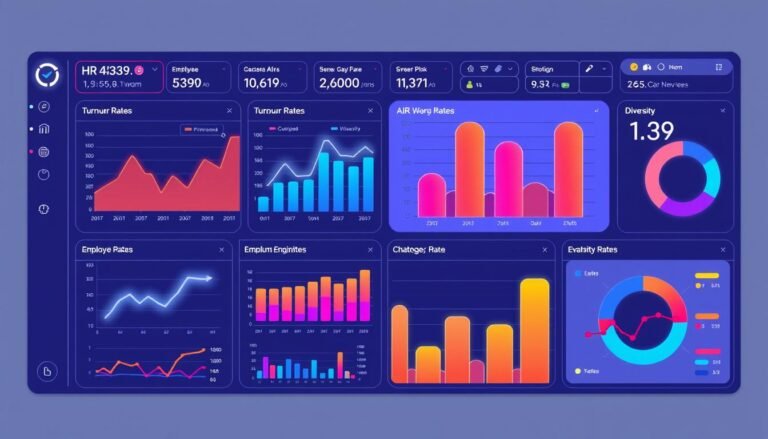Diversity, Equity, and Inclusion: Beyond Compliance
In today’s business world, diversity, equity, and inclusion (DEI) are more than buzzwords. They’re key to success. Companies that embrace DEI create workplaces where everyone can do their best.
Workplace inclusivity is more than hiring diverse talent. It’s about making sure all voices are heard and valued. When companies focus on equity, they make sure everyone has a fair chance. This leads to better ideas and stronger teams.
The numbers show that diverse companies outperform by 35%. Yet, only 12% of companies are truly inclusive. This gap shows there’s room for growth. By going beyond compliance, businesses can unlock their workforce’s full potential.
DEI isn’t just good for employees. It’s good for business too. Companies with diverse leadership see profits 33% higher. When employees feel valued, they’re more engaged and productive. This leads to better results across the board.
Key Takeaways
- DEI is crucial for business success, not just compliance
- Inclusive workplaces lead to better financial performance
- Only 12% of companies are truly inclusive, showing room for improvement
- Diverse leadership correlates with higher profitability
- DEI initiatives boost employee engagement and productivity
Understanding Diversity, Equity, and Inclusion
Diversity, equity, and inclusion (DEI) are key to modern workplaces. They shape the culture and success of organizations. Let’s dive into each part and why they’re important for a workplace where everyone can succeed.
What Does Diversity Mean?
Diversity covers many human differences. It includes obvious traits like race and gender, and less obvious ones like thinking styles and life experiences. Companies that value diversity see big benefits. For example, teams with diverse leaders are 25% more likely to be profitable.
The Importance of Equity
Equity means fair treatment and equal chances for everyone. It’s about making sure everyone has a fair shot. Companies that focus on equity are 75% more likely to have a team-focused culture. This makes employees more motivated and happy. Leaders who include everyone play a big role in equity.
Inclusion in the Workplace
Inclusion makes everyone feel valued and respected. It’s about creating a sense of belonging. Companies that focus on inclusion attract and keep the best talent. A study found that 40% of job seekers choose not to join if they think the company isn’t inclusive. Being aware of biases and understanding different cultures are essential for inclusion.
| DEI Element | Key Benefit | Impact |
|---|---|---|
| Diversity | Increased Profitability | 25% higher likelihood of above-average profits |
| Equity | Enhanced Teamwork | 75% more likely to have a pro-teamwork culture |
| Inclusion | Improved Talent Attraction | 40% of job seekers prioritize inclusive workplaces |
The Business Case for DEI
Diversity, Equity, and Inclusion (DEI) initiatives are more than just doing the right thing. They make good business sense. Companies that embrace DEI see big wins in innovation, financials, and culture.
How DEI Drives Innovation
Diverse teams bring new ideas to solving problems. Studies show inclusive teams make better decisions up to 87% of the time. This diversity leads to innovative solutions and prevents groupthink.
Financial Benefits of Inclusive Practices
The financial perks of DEI are clear. Companies with diverse executive teams outperform by 33% in profits. Inclusive practices boost employee engagement, with 83% of millennials more engaged in such cultures.
This engagement leads to real benefits:
- 17% increase in productivity
- 21% higher profitability
- 45% more likely to report market share growth
DEI also helps in attracting talent. 63% of millennials might leave if their employer doesn’t value diversity and inclusion. An inclusive culture attracts top talent and cuts down on turnover costs.
“Diversity is being invited to the party. Inclusion is being asked to dance.”
In today’s global market, DEI is essential, not just nice. It boosts innovation, financials, and culture. Companies embracing DEI better serve diverse customers, leading to more market share and success.
The Risks of a Compliance-Only Approach
Many companies see diversity, equity, and inclusion (DEI) as just a formality. This limited view can harm inclusivity and engagement in the workplace. Let’s look at why focusing only on compliance is not enough and how it affects company culture.
Consequences of Minimal Efforts
Organizations that barely invest in DEI miss its real advantages. A survey of 194 HR leaders showed that 63% aim to attract diverse talent. But, just hiring diverse people without creating an inclusive space can cause high turnover and low engagement.
Negative Impact on Company Culture
A focus only on compliance can harm a company’s culture and slow down innovation. Deloitte found that 74% of millennials believe inclusive cultures drive innovation. Without a real commitment to cultural intelligence, companies risk losing the best talent and damaging their reputation.
| Compliance-Only Approach | Holistic DEI Strategy |
|---|---|
| Surface-level changes | Deep cultural transformation |
| Potential legal issues | Increased employee satisfaction |
| Decreased productivity | Enhanced innovation |
| Higher turnover rates | Improved talent retention |
To really gain from DEI efforts, companies need to go beyond just following rules. By embracing inclusivity and developing cultural intelligence, they can improve engagement and create a vibrant, innovative workplace.
Creating a DEI Strategy
Creating a Diversity, Equity, and Inclusion (DEI) strategy is key for a welcoming workplace. Companies with diverse leaders do better financially, McKinsey found. This shows how important a good DEI plan is.
Assessing Current Practices
The first step is to check what’s already being done. Use surveys, interviews, and groups to hear from everyone. Knowing your company well helps make DEI efforts work better.
Setting Clear Objectives
Set goals that match your company’s mission. For example, aim to have more diverse leaders or better employee satisfaction. Studies show 83% of millennials work better in inclusive places.
Involving All Levels of Staff
Leadership that includes everyone is crucial for DEI success. Get all employees involved in making the plan. This way, everyone feels part of it and can point out specific issues.
Don’t just follow rules with DEI. It’s about making a place where everyone feels important and can do their best. This not only makes your workplace better but also helps you find more diverse talent.
Training and Development for DEI
Ongoing education is key to promoting Diversity, Equity, and Inclusion (DEI) in companies. Good training programs do more than follow rules. They aim to build real understanding and empathy among workers.
Importance of Ongoing Education
Learning about DEI all the time is essential for real change. A LinkedIn study shows 76% of employees value diversity when looking for jobs. This shows why companies must focus on DEI training to keep the best workers.
Types of Training Programs
Good DEI training covers many areas of workplace diversity:
- Bias Awareness workshops to spot and fight unconscious biases
- Cultural Intelligence seminars to improve communication across cultures
- Employee Engagement sessions on inclusive leadership
- Sexual harassment prevention training
- Workshops on the perks of a diverse team
Companies can also use fun, informal ways like DEI icebreaker games and Lunch & Learn sessions. These help teams find what they have in common and what makes them different. This builds a more welcoming work culture.
Custom DEI training should fit the business, industry, and work culture. By investing in thorough DEI education, companies can spark creativity, increase productivity, and make their workplace more welcoming.
Measuring DEI Success
It’s key to track how well Diversity, Equity, and Inclusion (DEI) efforts are doing. Companies that focus on DEI see big wins in keeping employees happy and having leaders who value everyone.
Key Performance Indicators (KPIs)
To see if DEI efforts are working, companies look at certain KPIs. These numbers show how things are going and where they need to get better. Some important ones are:
- How many diverse groups are in leadership roles
- Is everyone getting paid fairly?
- How happy are employees?
- Are more diverse groups staying with the company?
Studies show that companies with more women in leadership do better financially. They are 25% more likely to make more money. This shows why it’s important to keep working on diversity.
Gathering Employee Feedback
What employees say is very important for checking if DEI efforts are working. Companies can get this feedback in a few ways:
- Anonymous surveys
- Focus groups
- One-on-one talks
Listening to employees regularly helps make a workplace where everyone feels important and heard. Companies that value diversity keep their employees longer. This shows how important it is to keep employees happy and engaged.
| DEI Metric | Impact on Organization |
|---|---|
| Inclusive teams | 35% more productive |
| Gender diversity in leadership | 25% higher likelihood of above-average profitability |
| Diversity promotion | 2.6 times better workforce retention |
By always checking on DEI success and listening to employees, companies can make a more welcoming place. This boosts employee happiness and helps the business do better.
Building an Inclusive Culture
Creating a workplace where everyone feels valued is key to workplace inclusivity. Organizations that prioritize this see remarkable benefits. Let’s explore strategies for fostering belonging and celebrating diversity.
Strategies for Fostering Belonging
Building an inclusive culture starts with leadership. A study found that 82% of CEOs from major organizations focused on culture as a priority. Yet, only 27% of leaders reported their company as largely inclusive. To bridge this gap, companies can:
- Promote open communication
- Implement mentorship programs
- Create employee resource groups
These strategies help boost cultural intelligence and employee engagement. In fact, 87% of employees consider a sense of belonging critical to their performance.
Recognizing and Celebrating Diversity
Recognizing diversity goes beyond mere acknowledgment. It’s about actively celebrating differences. Companies that embrace this approach see tangible benefits:
| Benefit | Impact |
|---|---|
| Improved Performance | 35% outperformance by diverse teams |
| Innovation Leadership | 1.7 times more likely in inclusive cultures |
| Better Decision Making | 87% improvement with diverse teams |
| Lower Turnover | 42% reduction in inclusive organizations |
By fostering a culture of belonging, companies can tap into these benefits. This approach not only enhances workplace inclusivity but also drives innovation and boosts overall organizational performance.
Leadership’s Role in DEI
Leaders are key in building an inclusive workplace. They set the stage for Diversity, Equity, and Inclusion (DEI) efforts in their companies.
Leading by Example
Good leaders promote inclusive values and fair practices. They make sure diverse views are respected and valued. This leads to better teamwork and more creativity.
Senior leaders can help grow careers for underrepresented groups through mentorship. This shows a real commitment to diversity and inclusion.
Accountability in DEI Initiatives
Leaders must keep DEI a top priority. They use data to check if their efforts are working. This helps them make better choices and move forward.
| DEI Focus Area | Leadership Action | Impact |
|---|---|---|
| Bias Awareness | Mandatory training programs | Increased cultural competency |
| Inclusive Recruitment | Anonymous hiring processes | Diverse talent acquisition |
| Employee Engagement | Regular DEI surveys | Improved workplace satisfaction |
Leaders should invest in DEI efforts, like training and hiring programs. Working with outside groups can also help share knowledge and best practices.
“Inclusive leadership is not just about policies; it’s about creating a culture where every voice is heard and valued.”
By focusing on Bias Awareness and building an inclusive culture, leaders can make their companies welcoming and fair for everyone.
Community Engagement and Collaboration
Working with local communities boosts diversity efforts and builds cultural intelligence. Companies that team up with diverse groups open doors for learning and growth. This shows a real commitment to fairness in the community, not just in the workplace.
Partnering with Diverse Organizations
Teaming up with diverse groups helps in finding and keeping top talent. A 2019 survey found that 80% of U.S. consumers think companies should stand up for human rights. This shows how important partnerships are for a diverse and strong team.
Supporting Local DEI Efforts
Companies can help local diversity efforts by volunteering, sponsoring, and getting involved. This helps the community and makes the company look good. In fact, 76% of consumers see community work as key to a brand’s reputation.
| Consumer Expectations | Percentage |
|---|---|
| Believe companies should support social issues | 80% |
| Consider community engagement important for brand reputation | 76% |
| Believe companies should invest in future workforce education | 66% |
By getting involved in the community, companies can make a place more welcoming. This goes beyond just the workplace, helping to make society more diverse and fair.
Overcoming Common DEI Challenges
Companies face big hurdles when trying to make Diversity, Equity, and Inclusion (DEI) work. Two main problems are resistance to change and dealing with cultural differences. To solve these, we need a plan that includes learning about bias and understanding different cultures.
Addressing Resistance to Change
Change is hard for many people. In DEI, this resistance comes from not understanding or being scared. To fight this, we need leaders who welcome everyone and show the good of diversity. Slowly making changes and getting everyone involved can help.
Navigating Cultural Differences
Different cultures can lead to misunderstandings and fights at work. It’s key to learn about and respect these differences. Training that teaches about diversity and current issues helps everyone see things from different views.
Research shows that teaching about unconscious bias makes companies more welcoming. Blind hiring and using set interview questions help make choices based on skill, not bias.
“Diversity is being invited to the party; inclusion is being asked to dance.” – Verna Myers, Diversity Advocate
By tackling these problems, companies can make a place where everyone feels important and can do their best work.
The Future of DEI in the Workplace
Looking ahead, Workplace Inclusivity will shape the future of work. Companies now see that diverse teams lead to innovation and higher profits. In fact, businesses with more diversity often outperform others in these areas.
Trends to Watch
The world of Talent Acquisition is changing. Companies are now focusing on hiring strategies that bring in diverse talent. This move is not just about meeting numbers; it’s about creating spaces where different views can flourish. Diverse teams, especially in management, can lead to 19% more revenue from new ideas.
- Increased focus on intersectionality
- Growing emphasis on neurodiversity
- Rise of global inclusion initiatives
The Role of Technology in DEI
Technology is key in improving Employee Engagement and DEI efforts. AI tools help remove bias in hiring, and analytics make workplaces more inclusive. With more people working remotely, there are new chances to build inclusive online spaces.
| DEI Technology | Benefits |
|---|---|
| AI-powered hiring tools | Reduce bias in recruitment |
| Inclusive workplace analytics | Identify areas for improvement |
| Virtual collaboration platforms | Foster inclusive remote work |
The future of DEI in the workplace looks bright. By following these trends and using technology, companies can build inclusive spaces. These spaces will drive innovation, make employees happier, and improve overall performance.
Conclusion: Moving Beyond Compliance
The path to true diversity, equity, and inclusion goes beyond just following rules. Companies that make DEI a core value see big changes. For example, Tech Titan Inc. boosted minority leadership by 40% with detailed diversity training.
Embracing a Culture of Continuous Improvement
Building an inclusive workplace is a never-ending task. Green Solutions saw a big jump in employee happiness after growing their Employee Resource Groups (ERGs). This shows how crucial it is to create a place where everyone feels important and respected.
The Ongoing Journey of DEI
DEI is a journey, not a finish line. Market Innovators LLC leads by doing diversity audits twice a year. This keeps them ahead in a world that’s getting more diverse. By focusing on diversity and equity, companies can thrive and innovate for years to come.
Source Links
- Going beyond compliance to make DEI the cornerstone of… | G&A Partners
- Diversity and Inclusion: Go Beyond Compliance and Become Culture
- Beyond Compliance: The Importance of DEI in the Workplace – Diversio
- What is diversity, equity, and inclusion?
- Beyond the Buzzword: Real-World Diversity, Equity, and Inclusion Strategies – Last Eight Percent
- The business case for diversity equity and inclusion |
- The New Business Case for DEI
- Corporate America’s DEI dilemma: Balancing legal risks and diversity commitments
- Understanding the Relationship Between Inclusion, Diversity & Compliance | JD Supra
- The Unintended Negative Effects of Diversity and Inclusion Training (And How to Avoid Them)
- Diversity in Leadership: Enhancing DEI for Executive Success
- Beyond Compliance: How to Make Your DEI Training More Impactful
- DEI Strategic Planning & Roadmap | Diversio
- DEI Training: Building Diverse, Equitable and Inclusive Organizations | BizLibrary
- Creating Diversity, Equity, and Inclusion Training for the Workplace
- Diversity, Workplace Equity & DEI Training Programs | Diversio
- 9 DEI metrics and KPIs you should be tracking (+ examples) | Culture Amp
- How to Measure the Effectiveness and Impact of DEI Training
- The problem with current diversity and inclusion metrics – Diversily
- Creating an inclusive culture: Five principles to create significant and sustainable progress | Insights | Heidrick & Struggles
- Inclusive Culture: Fostering Diversity and Belonging – Culture Partners
- What Role Should Leadership Teams Play In DEI?
- Beyond Compliance: Building a Culture of True Inclusion
- Evidence-Based DEI Strategies for Executive Leaders – IIC Partners
- How Diversity, Equity & Inclusion Should Inform Your Community Engagement Efforts | EVERFI
- Top DEI Challenges in 2024 and How to Solve Them
- Overcoming the Top 5 Barriers to Diversity and Inclusion | Namecoach
- Challenges of DEI Data Consistency and How to Overcome Them | Diversio
- Beyond DEI Goals: Why Diversity in the Workplace Truly Matters General Assembly
- Embracing Diversity, Equity, and Inclusion (DEI) in the Modern Workplace
- Beyond Compliance: Fostering a Culture of Respect and Inclusion
- From diversity to inclusion
- Diversity, Equity, and Inclusion (DEI) Strategies: Moving Beyond Tokenism in the Workplace








